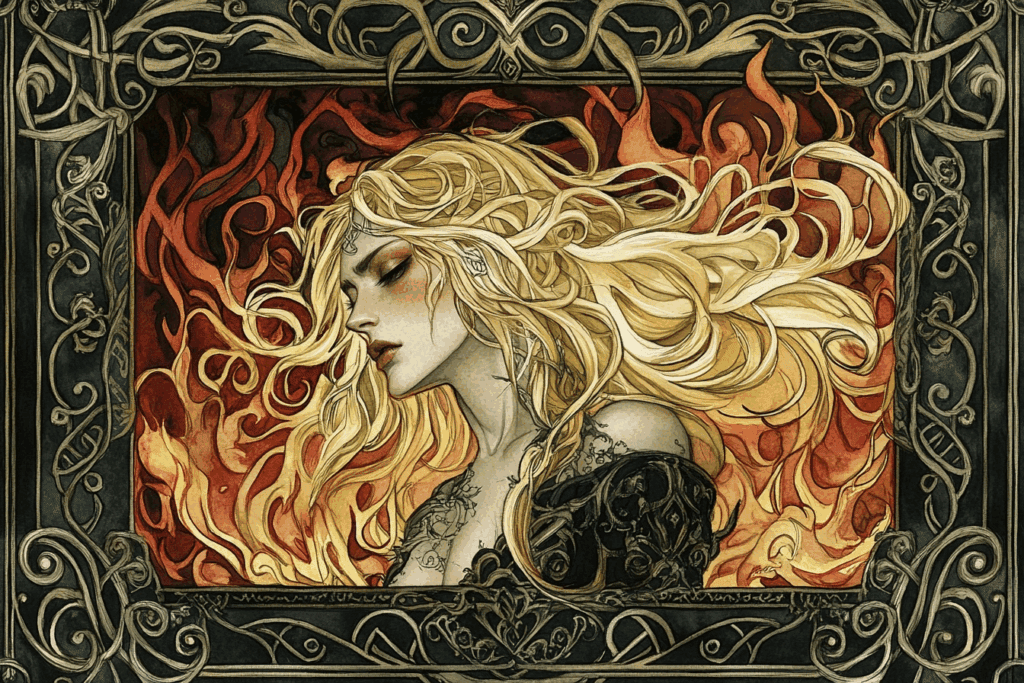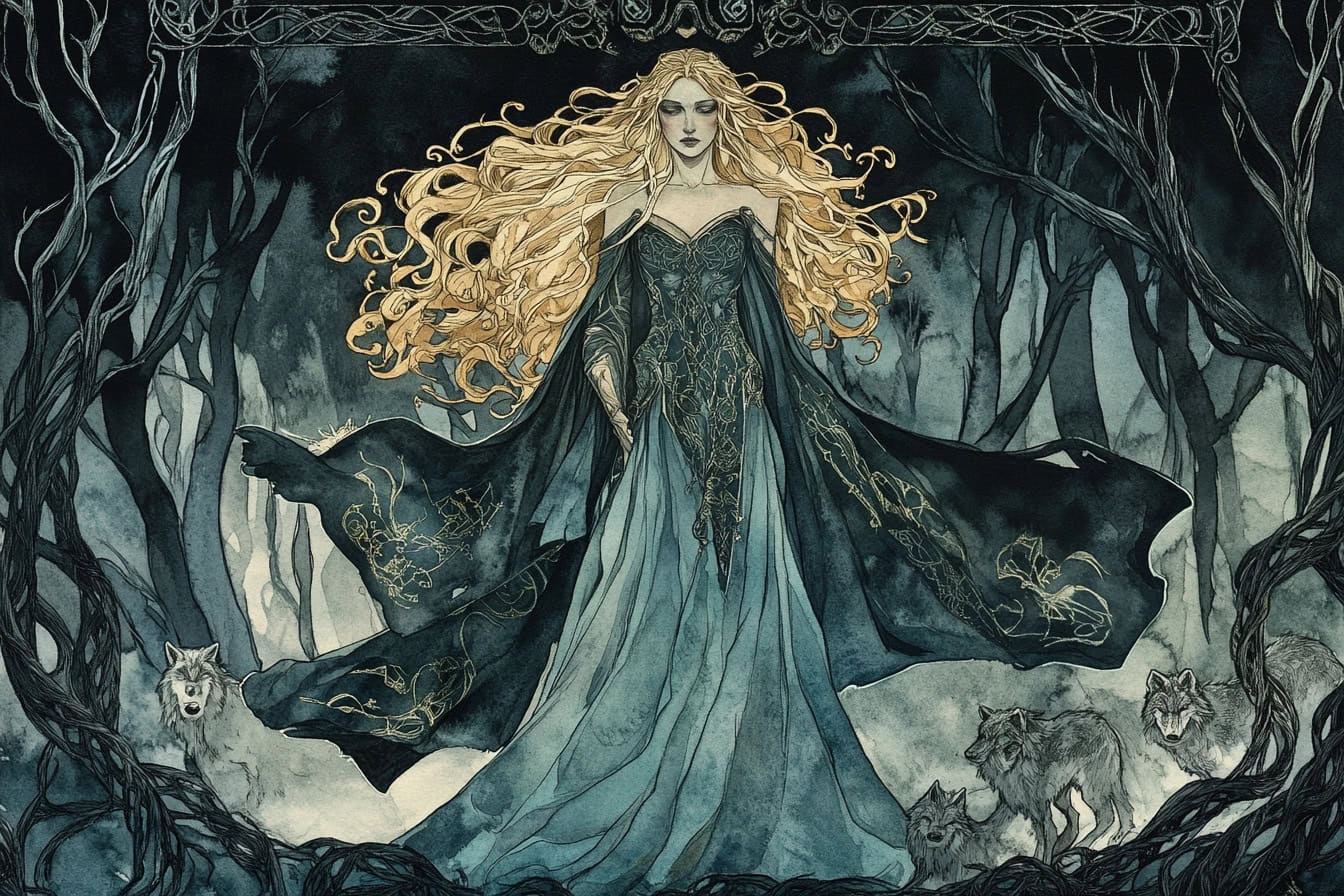No products in the cart.
June 10, 2025 5:50 am
June 10, 2025 5:50 am
In the haunting verses of the Völuspá, the foundational poem of the Poetic Edda, we are introduced to a woman who suffers and survives unimaginable violence: pierced by spears, burned three times, and yet she lives.
Her name is Gullveig. From the moment of her appearance, she stands at the crossroads of myth, magic, and the divine struggle between the Aesir and the Vanir.
Academic scholars have long debated her identity, her role, and her meaning. In this post, we turn to key academic voices to unravel the symbolic and historical complexity of Gullveig in Norse mythology.

The most direct and poetic source on Gullveig appears in stanzas 21–22 of the Völuspá, where she is described as being pierced by spears and burned in Odin’s hall. Despite this, she is reborn again and again.
Afterward, she is called Heið, a name associated with a seeress and the practice of seidr (magic).
Professor John Lindow explains that these verses are “obscure,” but make it “hardly going too far to say that Gullveig came to the hall of Odin, was attacked but could not be killed, and under the name Heid went about performing seid” (Lindow, 2001, p. 155).
In Lindow’s analysis, Gullveig may be an embodiment of Freyja herself, the Vanir goddess of love, fertility, and seidr.
Since Freyja is said to have introduced seidr to the Aesir, it is plausible that the narrative of Gullveig’s mistreatment represents a larger mythic tension between magical knowledge and patriarchal control—one that ignites the first war of the gods (Lindow, 2001, p. 155).
Swedish researcher Viktor Rydberg proposed a far-reaching theory that connects Gullveig with the monstrous and the maternal.
In the academic study Undersökningar i Germanisk Mythologi (1886), Rydberg identifies Gullveig with both Heið and Angrboda, the giantess known as the mother of Fenrir, Hel, and Jörmungandr.
He argues, “Det låter sig i sjelfva verket bevisas att Angrboda är densamma som Gullveig-Heid” (“It can actually be proven that Angrboda is the same as Gullveig-Heid”) (Rydberg, 1886, p. 163).
In this view, Gullveig is a chthonic mother-figure who births the cosmic forces of destruction.
Her persecution by the Aesir, then, represents a deeper mythic conflict: not simply between gods and giants, but between order and primordial, feminine chaos.
Rydberg further places Gullveig in the Ironwood (Járnviðr), where she births wolves and dark spirits. She is thus positioned as both mother and monster-maker—a liminal force that resists containment.

In her book Magie und Liminalität, German scholar Christina Künstner explores Gullveig as a fundamentally liminal figure.
Künstner interprets Gullveig through gendered taboos: as a woman who practices seidr, a form of magic socially and spiritually associated with femininity and taboo transgression.
Drawing on the work of Clive Tolley, she discusses how terms like brúðr (bride) and ergi (unmanliness or deviance) suggest that Gullveig represents a threat to patriarchal norms, particularly those related to sexuality, knowledge, and magical authority (Künstner, 2021, p. 121).
Künstner emphasizes Gullveig’s rejection and repeated burning as symbolic of cultural fear toward uncontrollable female power.
Her reemergence as Heið, a name commonly used for seeresses, underscores her role as a mediator between realms: life and death, order and chaos, divine and monstrous.
Künstner calls Gullveig a “prototypical unchaste woman,” not in the moralistic sense, but as a symbol of spiritual freedom and sexual autonomy (p. 122).

Earlier German scholarship also engages deeply with Gullveig’s mythic function.
In Zur Gigantomachie der Völuspá (1924) , the German scholar Eugen Mogk, who was an early expert in Old Norse literature, interprets Gullveig’s arrival and violent treatment as a cosmic and moral crisis.
According to Mogk, Gullveig’s presence among the Aesir causes them to lose their magical power and esteem among humans.
Her association with seidr (and her resistance to death) introduces a disruptive magical knowledge into the divine order (Mogk, 1924, p. 5–7).
Mogk explains that the Aesir burn Gullveig, but she returns as Heið and begins teaching humans magic.
In doing so, she removes sacred knowledge from the divine realm and places it in mortal hands.
Thus, her myth represents a transfer of power, as well as the beginning of the gods’ decline. Mogk states that Gullveig is the “cause of the gods’ loss of influence and prestige among humans” (1924,, p. 6).

Scholar H.R. Ellis Davidson adds another layer to this narrative. In her seminal work The Road to Hel, Davidson explores Gullveig’s link to ancient funerary practices and death cults.
She argues that the identity of Gullveig may have roots in prehistoric Scandinavian conceptions of the dead, particularly where female spirits (possibly elves or goddesses) were venerated through ritual (Davidson, 1943, p. 114–117).
Davidson notes that Gullveig’s connection with Heið and her association with Freyja and the Vanir gods ties her to fertility, death, and rebirth—especially in seasonal and agricultural rites.
Lindow, Künstner, and Rydberg all suggest in varying ways that Gullveig may be identical to Freyja, or at least mythologically aligned with her. Thematically, both are associated with:
In stanza 21 of the Völuspá, Gullveig is said to be burned “in Hár’s hall,” likely a reference to Odin. Afterward, she is reborn and renamed.
Freyja is similarly associated with both the Vanir and Aesir, and with bringing seidr to the gods.
Professor Lindow notes that even if Freyja is not identical to Gullveig, they both reflect the “disruptive entry of persons into a people” and the acquisition of sacred tools such as seidr and the mead of poetry (Lindow, 2001, p. 53).
Thus, the myth of Gullveig in Norse mythology may serve as a narrative of spiritual transformation: one that encodes the conflict between new and old forms of divine knowledge, as well as a mythic dramatization of patriarchal fear toward feminine spiritual power.

Across these scholarly interpretations, Gullveig emerges as a symbol of disruption, transformation, and survival.
Whether she is interpreted as Freyja in disguise, the mother of monsters, a liminal prophetess, or a threat to divine authority, her role in Norse mythology remains foundational.
Her repeated burning and rebirth echo deeper mythic themes: the cyclical nature of death and life, the contested boundary between gods and giants, and the volatility of divine order in the face of magic and the feminine.
Her story is not simply one of violence, but of resistance and return.
She is the spark that lights the fire of the gods’ first war, the bearer of forbidden knowledge, and the keeper of a mystery that continues to challenge scholars, readers, and spiritual seekers alike.
In Norse mythology, Gullveig is a thread of gold woven through flame—and she will not burn away.
Davidson, H.R. Ellis. The Road to Hel: A Study of the Conception of the Dead in Old Norse Literature. Cambridge: Cambridge University Press, 1943.
Künstner, Christina. Magie und Liminalität: Narrative, Gender und Alterität in der altisländischen Literatur. Universitätsverlag Winter, 2021.
Lindow, John. Norse Mythology: A Guide to the Gods, Heroes, Rituals, and Beliefs. Oxford University Press, 2001.
Mogk, Eugen. “Zur Gigantomachie der Völuspá.” FF Communications, no. 58, pp. 5–7. 1924.
Rydberg, Viktor. Undersökningar i Germanisk Mythologi. Vol. 1. Stockholm: Albert Bonnier, 1886.